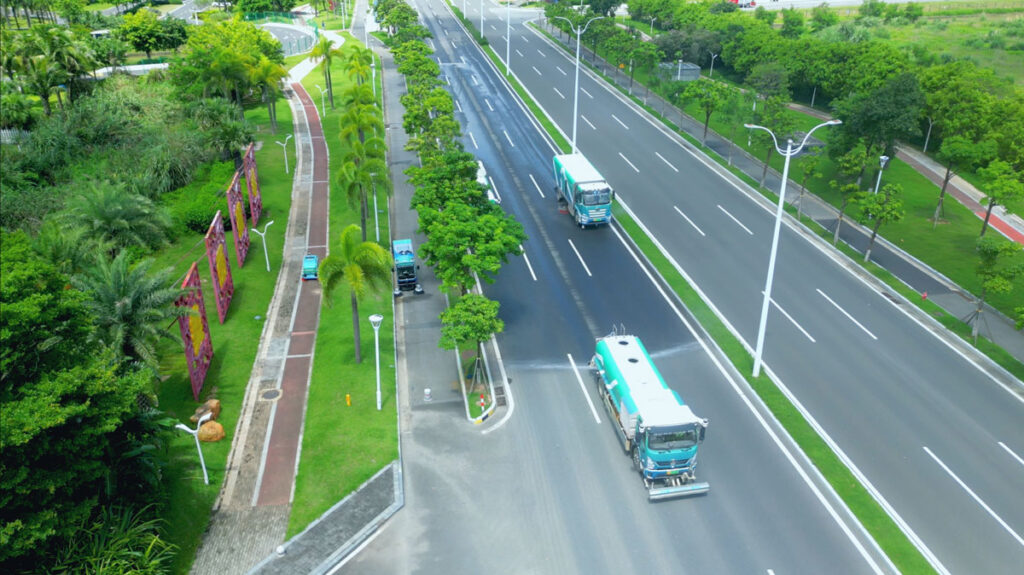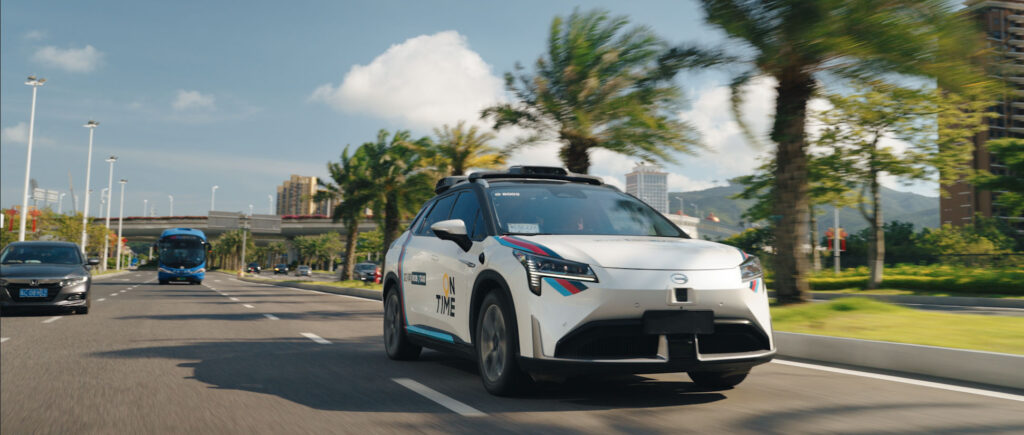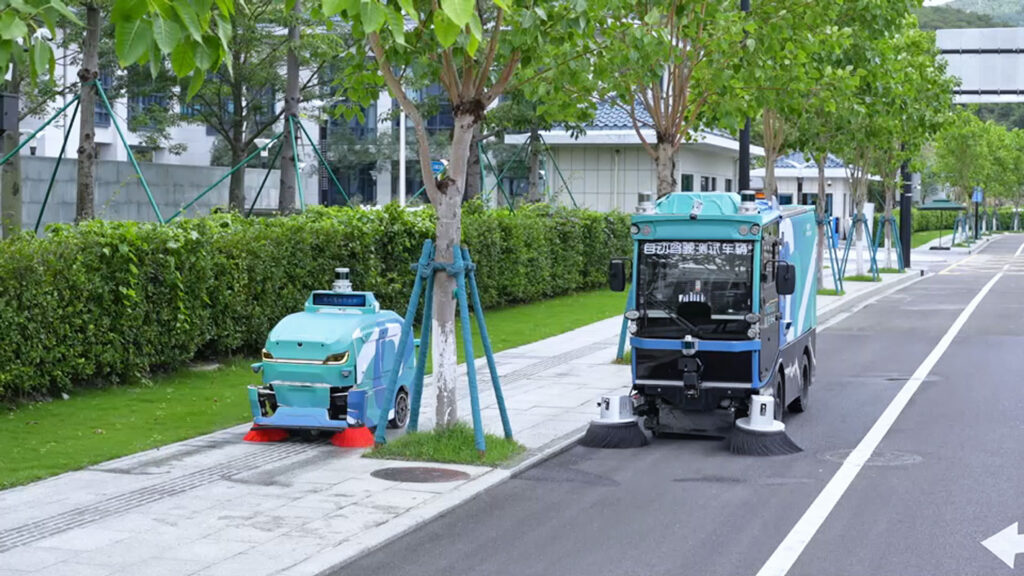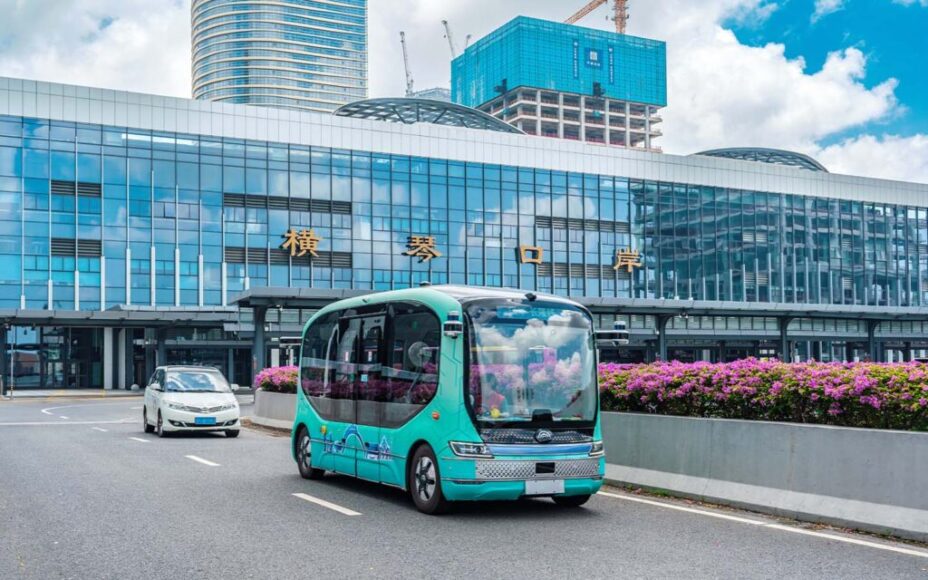Once the pipedream of science fiction writers, autonomous driving vehicles are now reality. From self-driving taxis to autonomous buses, China is leading the charge in this technological revolution: many of the nation’s citizens routinely use robotaxis on their daily commutes, tens of thousands of kilometres of the country’s roads are now open for autonomous driving vehicle testing, and more than a thousand Chinese companies are involved in bringing what are officially known as ‘intelligent connected vehicles’ (ICVs) to the world.
Excitingly, the Guangdong-Macao Intensive Cooperation Zone in Hengqin has emerged as a key region in this national scheme. Every single one of the 106-square-kilometre island’s roads – 330 kilometres of infrastructure in total – has been approved for ICV testing and demonstrations, accommodating everything from robotaxis to heavy-duty autonomous driving trucks that clean the streets. This means that Macao residents, who increasingly treat Hengqin as an extension of their own city, are also getting up close and personal with the futuristic leap in smart mobility.
Hengqin’s autonomous driving vehicle programme was first made public in the central authorities’ 2021 general plan for the island, Cheong Kok Kei, an official overseeing the fast-developing sector, told Macao magazine. The plan also shifted Hengqin’s administration from Guangdong Province alone to joint-command by Guangdong and Macao authorities. The ICV programme was part of a broader scheme to develop an artificial intelligence sector complementary to Macao’s drive for economic diversification.
Cheong is the director of the Intensive Cooperation Zone’s Urban Planning and Construction Bureau. His team began researching existing ICV testing areas in Beijing, Shanghai, Wuhan and Guangzhou in 2022. In August of that year, they established a “leading group for intelligent connected vehicles and driverless driving”. On-road tests and demonstrations officially started just one month later.
The ICV industry isn’t only on the move in China, though the country is considered by analysts to be experiencing significant growth compared with other markets. The size of the global autonomous driving vehicle market is poised for incredibly rapid expansion, according to forecasts from Statista. Valued at US$287.75 billion in 2024, it’s expected to be worth US$2.21 trillion in 2030 – an increase of over 670 percent.
Mastering driverless transportation

Currently, Hengqin’s autonomous vehicle fleet consists of 15 robobuses, 10 cleaning robots, five robotaxis, four compact street sweepers, two sprinkler trucks and one sweeper truck. The vehicles – which all boast a ‘highly driverless’ level 4 ranking based on the Society of Automotive Engineers’ (SAE) six levels of automation – come from four different companies, namely QCraft, WeRide, COWAROBOT and ONTIME Mobility. These pioneering ICV firms are headquartered around China, with WeRide located nearby in Guangdong Province’s Guangzhou.
The SAE standard for driving automation, which is recognised globally, describes level 4 automation as vehicles that can operate entirely without a driver – though human override is still an option. They also operate under certain parameters, including pre-specified routes and speeds.
Robotaxis were the first autonomous driving vehicles off the mark in Hengqin. Testing commenced in September 2022, followed by the first manned demonstration of robobuses’ abilities a few months later. Two years later, both types of vehicle launched commercial operations in Hengqin.
Several robobus lines currently transport passengers to various locations on the island, including the Hengqin Port, the Macao New Neighbourhood housing estate and Chimelong International Ocean Tourist Resort. Robotaxis, meanwhile, are operating around the Macao New Neighbourhood, Gang’ao Avenue, the Government Affairs Service Centre and the Hengqin Port.
The opening up of all Hengqin’s roads to ICVs was another 2024 milestone. This was also achieved in September, after a gradual rollout over the previous two years. Allowing the vehicles to traverse the whole island should be a drawcard for the local autonomous transportation sector, as it facilitates in-depth data collection, says Cheong.
“These roads cover various traffic conditions in Hengqin,” he explains. “This not only further tests the autonomous driving vehicle’s perception and functional capability, but also helps the car companies to collect even more comprehensive road data.” The civil servant notes that such information can be used to “optimise the autonomous driving algorithm and further strengthen the public’s confidence and acceptance of autonomous driving technology.”
On the latter point, Cheong points out that robobuses and robotaxis give residents “even more options” for moving around Hengqin. Most importantly, he describes the transportation experience they provide as “smart, safe and comfortable”.
An industry promoting integration
According to Cheong, the commercialisation of robotaxis will “help promote Hengqin’s coordinated regional development and drive the [Guangdong-Hong Kong-Macao Greater Bay Area] GBA’s building of intelligent transportation.”
Macao plays an active role in developing Hengqin’s autonomous driving vehicle sector, he adds, pointing to his department’s close collaboration with the University of Macau (UM). A team from UM is involved in coordinating the vehicles’ visual perceptions, decision-making and control mechanisms. The sector also benefits from Macao’s well-developed exposition landscape: Hengqin’s autonomous driving vehicles have been showcased at the Special Administrative Region’s Beyond Expo, for instance – an international stage enabling a broader audience to engage with the emerging technology.
What’s it like to go driverless?

The technology may be complex, but the act of travelling by robobus or robotaxi is remarkably straightforward. They stop when required, allow passengers to climb aboard safely and perform exactly as a conventional vehicle would on the roads – changing lanes smoothly and pausing for traffic lights – before letting you out when you reach your destination. They just do it all without a human at the wheel. The experience can feel a little uncanny at first, but quickly becomes routine.
Booking a robotaxi is an intuitive process that works in the same way as a normal ride-hailing service like Uber or DiDi (both available in Hengqin, though not Macao). All potential passengers have to do is download a compatible mobile app, like ONTIME Mobility, select the unmanned Robotaxi option, enter their location and destination, and wait for the vehicle to arrive. The only major difference is that upon boarding the vehicle, instead of greeting your driver, you confirm your ride through an onboard monitor system.
While the idea of travelling in an autonomous driving vehicle may still sound nerve-wracking to some, Hengqin’s robobuses and robotaxis all conform with regulatory guidelines formulated to ensure passenger safety. Surveillance cameras feed real-time footage to the platform monitoring each vehicle, for instance, while a ‘T-Box’ – similar to an aeroplane’s black box – allows for real-time data collection covering practically every other aspect of the vehicle’s movements. “This includes data relating to the vehicle’s position, speed, driving status and the monitoring of a safety personnel’s actions,” Cheong explains.
According to Cheong, autonomous transportation is rapidly gaining acceptance in Hengqin. As of December 2024, the vehicles had travelled a cumulative distance of more than 480,000 kilometres and carted more than 60,000 people – including upwards of 16,000 Macao residents.
The future of autonomous driving vehicles in Hengqin and beyond

Aside from Hengqin, other GBA cities including Guangzhou and Shenzhen have also been embracing ICVs. In 2024, Guangzhou introduced a pilot programme for the commercialisation of autonomous driving cars in its Nansha district, and began drafting legislation to support the industry that same year. Shenzhen, meanwhile, launched its first four autonomous driving public bus routes last year. The city has also opened up 1,560 kilometres of its public roads for ICV testing.
When asked how Hengqin’s autonomous driving transportation sector compares, Cheong says that the island is “on par” with the larger Chinese cities in terms of the types of vehicles in use, progress in their commercialisation and the extent of roading network able to be accessed.
The civil servant concedes that there’s one area where Hengin is lagging: there aren’t many ICV companies and research outfits based there. Cheong says this is something local authorities are working to improve and hopes are high that recent developments will raise Hengqin’s profile within the wider industry. Along with the roads opening up last year, plans are afoot to widen the current contexts under which autonomous driving vehicles are used.
“Hengqin will make use of its unique strengths arising from its geographic advantages and implementation of early and pilot policies to establish itself as an important platform for domestic autonomous driving enterprises wishing to enter into the international market,” Cheong says.
If the dynamic pace at which Hengqin’s industry has developed over the past two years is anything to go by, it’s well on its way to achieving this goal.



